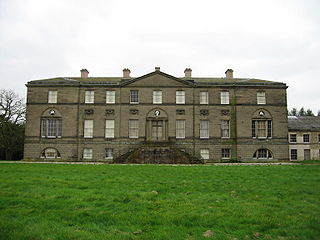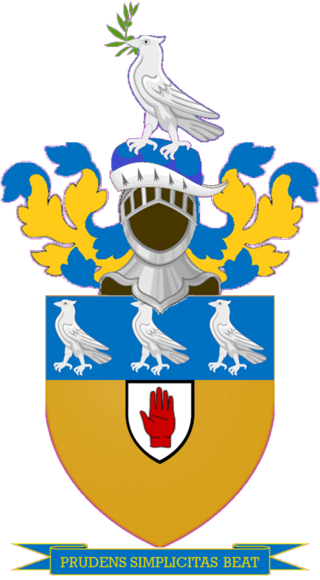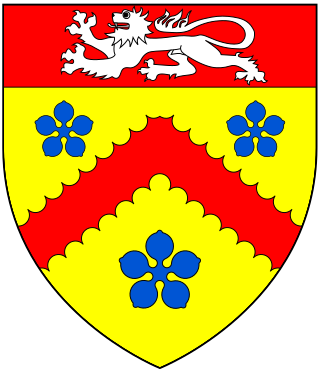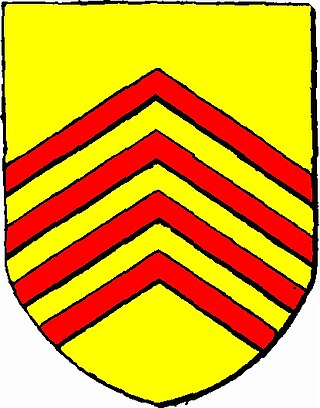
Viscount Gage, of Castle Island in the County of Kerry of the Kingdom of Ireland, is a title in the Peerage of Ireland. It was created in 1720 for Thomas Gage, along with the subsidiary title of Baron Gage, of Castlebar in the County of Mayo, also in the Peerage of Ireland. In 1744 he also succeeded his cousin as eighth Baronet, of Firle Place. The titles remain united. The Gage family descends from John Gage, who was created a baronet, of Firle Place in the County of Sussex, in the Baronetage of England on 26 March 1622. His great-grandson, the seventh Baronet, represented Seaford in Parliament. He was succeeded by his first cousin, Thomas Gage, 1st Viscount Gage, the eighth Baronet. He sat as a Member of Parliament for Minehead and Tewkesbury and also served as Governor of Barbados. In 1720, 24 years before succeeding in the baronetcy, he was raised to the Peerage of Ireland as Baron Gage and Viscount Gage. His second son was the military commander the Hon. Thomas Gage.

There have been three baronetcies created for members of the Bacon family, all in the Baronetage of England. As of 2008, one creation is extinct and two of the creations are extant. The extant titles have been merged since 1755.

The Broughton, later Broughton-Delves, later Broughton Baronetcy, of Broughton in the County of Stafford, is a title in the Baronetage of England. It was created on 10 March 1661 for Sir Brian Broughton, of Broughton Hall, near Eccleshall, Staffordshire, High Sheriff of Staffordshire from 1660 to 1661 and the member of an ancient Staffordshire family.

The Bunbury Baronetcy, of Bunbury, Oxon and Stanney Hall in the County of Chester, is a title in the Baronetage of England. It was created on 29 June 1681 for Thomas Bunbury, Sheriff of Cheshire from 1673 to 1674 and the member of an ancient Cheshire family. His grandson, Henry, the third Baronet, and great-grandson, the fourth Baronet, both sat as Members of Parliament for Chester. The latter died unmarried at an early age and was succeeded by his younger brother, the fifth Baronet. He was a clergyman. On his death in 1764 the title passed to his eldest son, the sixth Baronet. He represented Suffolk in the House of Commons for over forty years but is best remembered for his marriage to Lady Sarah Lennox. He died childless in 1821 and was succeeded by his nephew, the seventh Baronet. He was the son of Henry Bunbury, younger son of the fifth Baronet. The seventh Baronet was a distinguished soldier and politician. His eldest son, the eighth Baronet, was High Sheriff of Suffolk in 1868, and Fellow of the Royal Society. He died childless in 1886 and was succeeded by his younger brother, the ninth Baronet. He was Liberal Member of Parliament for Bury St Edmunds. He died unmarried in 1895 and was succeeded by his nephew, the tenth Baronet. He was the son of Colonel Henry William St Pierre Bunbury, third son of the seventh Baronet. He served as High Sheriff of Suffolk in 1908 and was a Deputy Lieutenant of the county. On his death in 1930 the title passed to his son, the eleventh Baronet. He was High Sheriff of Suffolk in 1936 and was a Deputy Lieutenant of the county. His son, the twelfth Baronet, was High Sheriff of Suffolk in 1972. As of 2014 the title was held by the latter's second but eldest surviving son, the thirteenth Baronet, who succeeded in 1985.

There have been three baronetcies created for persons with the surname Burdett, two in the Baronetage of England and one in the Baronetage of Ireland. As of 2008, two of the creations are extant while one is dormant.
There have been two baronetcies created for persons with the surname Warner, one in the Baronetage of England and one in the Baronetage of the United Kingdom. One creation is extant as of 2010.
There have been three baronetcies created for persons with the surname Bellingham, one in the Baronetage of England, one in the Baronetage of Ireland and one in the Baronetage of Great Britain. As of 2014 one creation is extant.
There have been two baronetcies created for people with the surname Cholmeley, one in the Baronetage of England and one in the Baronetage of the United Kingdom. One creation is extant as of 2008. The family surname is pronounced "Chumley".
There have been three baronetcies created for persons with the surname Wilmot, one in the Baronetage of Ireland and two in the Baronetage of Great Britain. One creation is extant as of 2008.

There have been two baronetcies created for persons with the surname Boothby, both in the Baronetage of England. One creation is extant as of 2022.
There have been three baronetcies created for persons with the surname Pole, one in the Baronetage of England, one in the Baronetage of Great Britain and one in the Baronetage of the United Kingdom. Two of the creations are extant as of 2008.

The Harpur Baronetcy, of Calke Abbey, Derbyshire was a title in the Baronetage of England. It was created on 8 September 1626 for Henry Harpur. He was a grandson of Richard Harpur, Justice of the Common Pleas, of Swarkestone Hall, Swarkestone, Derbyshire. The fourth Baronet was High Sheriff of Derbyshire in 1702. He married Catherine, daughter of Thomas Crewe, 2nd Baron Crew. The fifth Baronet sat as Member of Parliament for Worcester and Tamworth. The sixth Baronet was Member of Parliament for Derbyshire. The seventh Baronet assumed the alternative surname of Crewe in 1808 in commemoration of his ancestry. The eighth Baronet sat as Member of Parliament for Derbyshire South. The ninth Baronet assumed the surname Harpur Crewe and was High Sheriff of Derbyshire in 1853. The tenth Baronet was High Sheriff of Derbyshire in 1900. The title became extinct on his death in 1924.

The Frederick Baronetcy, of Burwood House in the County of Surrey, is a title in the Baronetage of Great Britain. It was created on 10 June 1723 for John Frederick of Burwood House in the southern half of Walton-on-Thames which later became Hersham.

The Lambert Baronetcy, of London, is a title in the Baronetage of Great Britain. It was created on 16 February 1711 for John Lambert, a French-born merchant who had settled in England. He was a Director of the South Sea Company and was created a Baronet for supplying the Treasury with loans. The seventh Baronet, who served as high sheriff of Worcestershire in 1901, assumed in 1905 by Royal licence the surname of Grey for himself and issue in lieu of his patronymic. This surname was also borne by the eighth Baronet.
There have been two baronetcies created for persons with the surname Hawley, one in the Baronetage of England and one in the Baronetage of Great Britain.

The Wake Baronetcy, of Clevedon in the County of Somerset, is a title in the Baronetage of England. It was created on 5 December 1621 for Baldwin Wake. The sixth Baronet assumed the additional surname of Jones but died childless. The eighth Baronet sat as Member of Parliament for Bedford. The twelfth Baronet was High Sheriff of Northamptonshire in 1879. The thirteenth Baronet was a Major-General in the British Army. Another member of the family to gain distinction was Charles Wake, second son of the tenth Baronet; he was an Admiral in the Royal Navy.
There have been four baronetcies created for members of the Thorold family of Lincolnshire, two in the Baronetage of England and two in the Baronetage of Great Britain. As of 2014 one creation is extant.

There have been two baronetcies created for persons with the surname Goring, both in the Baronetage of England. The second creation came into the family through a special remainder in the patent creating the baronetcy. Only the latter creation is extant as of 2008.

There have been three baronetcies created for persons with the surname Cooke, two in the Baronetage of England and one in the Baronetage of Ireland. One creation is extant as of 2013.

The Everys are an historic English family from the West Country, traceable to the late 12th century and maternal cousins to the Brice family. They were significant landowners in Devon, particularly in Chardstock and Shepton Beauchamp, and as Lords of the manor of Wootton Abbotts. The family seats were Wycroft Castle, Wootton Abbotts manor house, and Egginton Hall. On 26 May 1641 a branch of the family developed into the Every baronets, and the late 17th-century English pirate Henry Every is believed to have descended from an earlier line.














